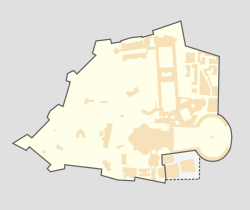Paul VI Audience Hall
Building in Rome From Wikipedia, the free encyclopedia
The Paul VI Audience Hall (Italian: Aula Paolo VI), also known as the Hall of the Pontifical Audiences, is an audience hall in which the Pope has held various audiences and conferences.
 The Paul VI Audience Hall as seen from the roof of St. Peter's Basilica. | |
| Construction | |
|---|---|
| Opened | 1971 |
| Architect | Pier Luigi Nervi |

Description
The hall has a seating capacity of 6,300, designed in reinforced concrete by the Italian architect Pier Luigi Nervi and completed in 1971.[1] It was constructed on land donated by the Knights of Columbus and is named for Pope St. Paul VI.[2]
It lies partially in the Vatican City but mostly in Rome: the Italian part of the building is treated as an extraterritorial area of the Holy See, and is used by the pope as an alternative to St. Peter's Square when conducting his Wednesday morning General Audience. It is dominated by an 800-quintal (80-tonne) bronze/copper-alloy[3] sculpture by Pericle Fazzini entitled La Resurrezione (Italian for The Resurrection).[4][5] A smaller meeting hall, known as Synod Hall (Aula del Sinodo), is located in the building as well. This hall sits at the east end on a second floor.
On 25 May 2007, it was revealed that the roof of the building was to be covered with 2,400 photovoltaic panels, generating sufficient electricity to supply all the heating, cooling and lighting needs of the building throughout the year.[6][7] The system was donated by SolarWorld, a German manufacturer, and valued at $1.5 million. It was officially placed into service on 26 November 2008, and was awarded the 2008 European Solar Prize[8] in the category for "Solar architecture and urban development".[9]
References
Further reading
Wikiwand in your browser!
Seamless Wikipedia browsing. On steroids.
Every time you click a link to Wikipedia, Wiktionary or Wikiquote in your browser's search results, it will show the modern Wikiwand interface.
Wikiwand extension is a five stars, simple, with minimum permission required to keep your browsing private, safe and transparent.

